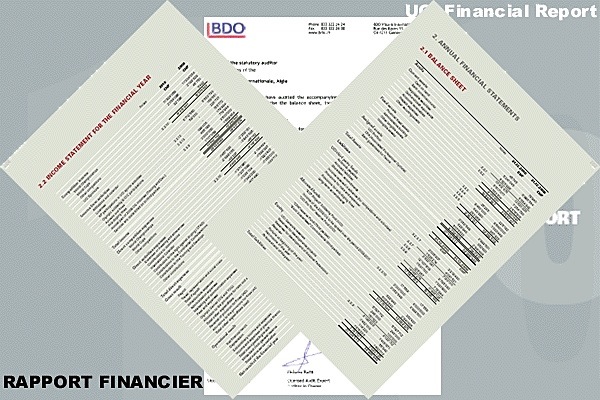In this latest part of our series looking at some of the key issues in the revenue-sharing debate we wrap up our look at the UCI’s 2010 financial statements with a daft analogy before pulling back the UCI’s balance sheet to have a look at the body beneath.
Daft analogy time. (Even I hate this analogy, but I’ll use it anway.) We began this examination of the UCI’s financial statements by saying that the UCI had taken a long, hard look at itself in the mirror and found the reflection to be far from flattering. The UCI was fat and flabby and in serious need of some body sculpting. The UCI also needed to consider its cholesterol levels.
Imagine if you can – and please, just run with me on this one, it’s a dumb analogy, I know, but it works – the UCI’s prime artery and all the cholesterol clinging to its walls. Let’s pretend you can measure the width of an artery in Swiss francs (look, I’ve already admitted this is dumb, get over it and run with the idea). At the end of 2007 the UCI’s artery was 12.8 million Swiss francs wide (in the real world, that was the value of the UCI’s accumulated reserves at the end of 2007).
Over the course of 2008, with more cholesterol clinging to the walls of the UCI’s blood vessels, the artery only measured 8.7 million Swiss francs in width (in the real world, that was the value of the UCI’s accumulated reserves at the end of 2008). If the UCI had continued adding cholesterol at its 2008 rate the artery would have been fully blocked in two years. The UCI was a basket case. The doctors ordered the patient to change its diet or die.
The UCI’s changed diet meant that less cholesterol was added to its artery walls in 2009. But the artery still shrank some more. At the end of 2009, it was only 7.6 million Swiss francs wide (again, in the real world, that was the value of the UCI’s accumulated reserves at the end of 2009). If the UCI continued to add cholesterol at the 2009 rate, the artery would be fully blocked in six years. An improvement over the previous year, but still leaving the UCI as a bit of a basket case.
In 2010, the UCI seems to have finally put some control on its diet. No new cholestrol was added to its artery walls. In fact, a small amount of cholesterol was scraped away, the artery measuring 7.8 million Swiss francs in width at the end of 2010 (yes, you’ve got it by now, that was the value of the UCI’s accumulated reserves at the end of 2010).
Does this mean that the UCI has a clean bill of health? Hardly. We’ve already seen how the effects of fluctuating currencies can catch the UCI unawares. So even though the UCI made a small surplus last year, the patient still needs to be monitored. All that’s happened is that its condition appears to have stabilised. It would be very easy to slip back into bad habits. Like being caught unawares by fluctuating exchange rates. Or the cost of taking major anti-doping cases to the CAS.
The general trend, then, has been favourable over the last two years. The rest of 2011 could still be quite ropey, though. For starters, there’s the cost of the interminable case of Alberto Contador, which is exacerbated somewhat by WADA taking their appeal independent of the UCI’s appeal. Thankfully, though, the rest of the peloton has been sufficiently careful to protect the UCI from unexcepted financial outlays this year. Though clearly not as careful as they should be, not if Pat McQuaid’s recent warning to the peloton about the dangers of micro-dosing is anything to go by.
* * * * *
Dumb and all as the cholesterol analogy is, it beats talking about burn rates and the like and it does capture how close the UCI is to running out of money. But really, can you seriously imagine the UCI running out of reserves? Here you have to recall that the UCI is not really a business. It’s actually little more than a club. A bloody big club yes, but still a club.
What happens when clubs run out of money? They organise a raffle and all the members buy tickets and pester their friends and family into buying tickets. How many tickets do you think Igor Makarov and his oil-rich Russian friends would buy were the prize the presidency of the UCI? Or would maybe Hein Verbruggen’s SportAccord be willing to pop for a couple of books of tickets were the prize the CADF? And how many tickets do you think ASO or Lagardère Unlimited would be willing to purchase were the prize the UCI’s new race promotion arm, Global Cycling Promotions?
Some of you are no doubt shaking your head and thinking I’m just talking up some bogeymen here. There may even be some truth to that. Accountants are, after all, just story-tellers and maybe some of the story I’m telling here is just a scare before bedtime.
But the UCI has already organised a number of raffles in recent memory. In one of them the prize was a slot in the Olympic track cycling programme. The Japanese keirin promoters were the lucky winners of that. And, if some are to be believed, another prize was the magicking away of a non-negative doping control at the Tour de Suisse some years back. The truth is, I don’t need to try very hard to scare you: reality is frightening enough as it is.
The answer then to my question as to whether there was ever a real danger of the UCI running out of reserves is that, while there is always a theoretical danger, it’s actually a very unlikely scenario. The real danger is in what would have to be raffled were the UCI caught unawares by a financial catastrophe and need to raise funds in a hurry.
* * * * *
Though the UCI is just a glorified club, it would like to think of itself as a major player on the global sporting stage. Look at how Pat McQuaid set his sights on making the UCI the recognised Olympic body for skateboarders. Whatever it takes to extend the UCI’s powerbase, McQuaid will do it. But just how major is the UCI really? We’ve already looked at different aspects of its income statement and will be coming back to other items buried within that as this series progresses. Let’s now look at the UCI’s balance sheet and see what story it tells us.
|
As at 31 December 2010 |
2009 |
2008 |
|||
| Fixed Assets | |||||
| Financial |
25,285 |
225,182 |
243,782 |
||
| Property |
8,460,000 |
8,640,000 |
8,820,000 |
||
| Other |
643,980 |
1,033,448 |
1,493,519 |
||
|
9,129,265 |
9,898,630 |
10,557,301 |
|||
| Intangibles |
263,856 |
367,929 |
482,456 |
||
|
9,393,121 |
10,266,559 |
11,039,757 |
|||
| Current Assets | |||||
| Cash on hand |
45,745 |
78,840 |
81,327 |
||
| Cash in bank |
5,241,045 |
6,986,544 |
16,644,901 |
||
| Securities |
5,525,886 |
5,554,842 |
5,166,940 |
||
|
10,812,676 |
12,620,226 |
21,893,168 |
|||
| Receivables |
6,617,077 |
7,254,730 |
5,935,278 |
||
| Prepayments |
1,553,614 |
2,676,916 |
2,137,657 |
||
|
8,170,691 |
9,931,646 |
8,072,935 |
|||
|
18,983,367 |
22,551,872 |
29,966,103 |
|||
| Assigned Assets | |||||
| ProTour |
3,053,549 |
3,888,501 |
3,806,774 |
||
| CPA |
628,843 |
352,420 |
1,729,938 |
||
| Guarantees |
5,075,633 |
2,841,495 |
3,798,260 |
||
|
8,758,025 |
7,082,416 |
9,334,972 |
|||
| Total Assets |
37,134,513 |
39,900,847 |
50,340,832 |
||
| Third Party Funds | |||||
| Payables |
(2,005,807) |
(3,218,490) |
(3,033,210) |
||
| Accruals |
(1,526,274) |
(4,091,521) |
(5,017,711) |
||
|
(3,532,081) |
(7,310,011) |
(8,050,921) |
|||
| Income in advance |
(12,107,619) |
(9,785,390) |
(10,577,895) |
||
| Mortgage |
0 |
0 |
(3,000,000) |
||
| Provisions – expenses |
(1,631,700) |
(1,330,800) |
(1,139,100) |
||
| Provisions – fines |
(325,957) |
(778,944) |
0 |
||
|
(14,065,276) |
(11,895,134) |
(14,716,995) |
|||
|
(17,597,357) |
(19,205,145) |
(22,767,916) |
|||
| Allocated Funds | |||||
| ECF Solidarity Fund |
(17,559) |
(17,559) |
(17,559) |
||
| Olympics |
(3,000,000) |
(6,000,000) |
(9,500,000) |
||
|
(3,017,559) |
(6,017,559) |
(9,517,559) |
|||
| ProTour Reserve |
(3,053,549) |
(3,888,501) |
(3,806,775) |
||
| CPA Reserve |
(628,843) |
(352,420) |
(1,729,938) |
||
| Guarantees |
(5,075,633) |
(2,841,495) |
(3,798,260) |
||
|
(8,758,025) |
(7,082,416) |
(9,334,973) |
|||
|
(11,775,584) |
(13,099,975) |
(18,852,532) |
|||
| Total Liabilities |
(29,372,941) |
(32,305,120) |
(41,620,448) |
||
| Total Net Assets |
7,761,572 |
7,595,727 |
8,720,384 |
||
| Equity | |||||
| General Reserve |
5,787,712 |
5,787,712 |
7,067,712 |
||
| Development Reserves |
246,000 |
246,000 |
246,000 |
||
| Federations’ Reserves |
151,623 |
100,000 |
0 |
||
|
6,185,335 |
6,133,712 |
7,313,712 |
|||
| Accumulated Surplus |
1,576,236 |
1,462,013 |
1,406,670 |
||
| Total Reserves |
7,761,571 |
7,595,725 |
8,720,382 |
||
I have slightly altered the layout of the balance sheet, as compared with the version shown in the UCI’s accounts. If you’ve looked at the UCI’s accounts, my reason for doing this will be obvious to you. If you haven’t, don’t sweat it.
Of the numbers themselves, what is there to say? Detailed and all as the picture appears to be to be, there’s actually very little in it. The UCI’s is actually quite a simple balance sheet.
Some of you may be looking at the 5.2 million Swiss francs in the bank and the other 5.5 million held in securities. Scroll down a few lines though and consider the 12.1 million figure for income in advance. As we established earlier in this series, the UCI can receive money one, two, or more years in advance, from sponsors, race organisers or teams.
Most of the assets need to be considered in association with their matched liabilities. While a total assets figure of 37.1 million Swiss francs looks wonderful if considered in isolation, once you consider the matched liabilities of 29.4 million it’s not nearly as impressive as it at first seems.
Large amounts of the UCI’s balance sheet don’t actually belong to the UCI. Take the Assigned Assets of 8.8 million Swiss francs. Scroll down a few lines and you will see the liabilities matching these. While the assets sit on the UCI’s books, technically they don’t belong to the UCI. The money is, so to speak, ony resting in the UCI’s accounts. The guarantees figure, for instance, is the money lodged by teams to pay salaries in case they go bust. That’s a necessary precautionary measure, as riders from teams like Mercury, Team Coast or the Linda McCartney Pro Cycling Team will tell you. But that’s all it is: a precautionary measure.
One of those allocated funds though is worth considering in more detail: the ProTour reserve. When it comes to this, there’s some major obfuscation going on in the UCI’s accounts, with this being the only section denominated in Euros. You’d almost think there was something being hidden here. Like the €445,000 of Global Cycling Promotion’s costs picked up – via the ProTour reserve – by the UCI in 2010 and the €177,000 picked up in 2009. Or the €30,000 subvention given to the GP Ouest France-Plouay to ease the cost of being on the World Tour calendar (increased prize fund, inceased CADF contribution, increased calander fee and increased licence fee – what the right hand giveth, the left hand taketh).
The most interesting number is the one we’ve already looked at using the rather silly blocked-artery analogy: the UCI’s total reserves (or, looked at from the other side of the balance sheet, it’s total net assets). For a global sporting behemoth, 7.8 million Swiss francs is not a very big bottom line. At the year-end exchange rate, that was only €6.2 million ($8.3 million). You could win more on the Lottery most weeks. And certain members of the UCI’s management and other committees are worth more than the UCI is.
The question though needs to be asked as to whether the UCI should have a large accumulated reserve. Should we be demanding a bottom line of massive proprtions or should we just be happy with what’s on offer? The answer to that is another question: what is the UCI there to do and how much money does it really need to do it?
This is a question I have no intention of attempting to answer, claiming it’s beyond the scope of the revenue-sharing issues I want to look at in the rest of this series. But, as we progress, and you see the large amounts of cash the UCI is taking from teams and race organisers, it’s a question you might want to ask others to answer. Or even try and formulate an answer of your own to.
Next: Revenue sharing as it exists today.
Previous: Where do you hide a tree?















2 Comments
[…] Monitoring the UCI’s cholesterol levels. Tags: AIGCP, ASO, Prize Money, Revenue Sharing, Tour de France function fbs_click() […]
[…] Next: Measuring the UCI’s cholesterol levels. […]